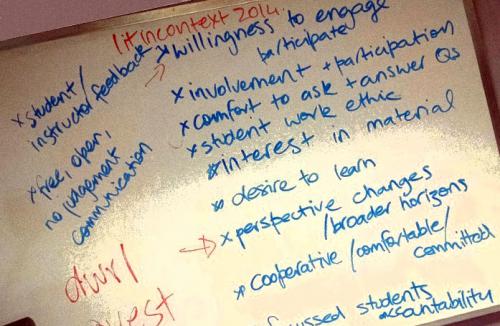You are here
Fostering a Feminist Classroom Climate
Primary tabs

Beck Wise.
In this icebreaking activity, students think-pair-share on the question "What makes a class a success?" This gives them the opportunity to meet a new classmate and contribute to setting the classroom tone for the semester ahead.
The primary goal of this assignment is to open the class, both literally -- it's a Day One icebreaker -- and figuratively, by disrupting the traditional power structures of the classroom, inviting student voices in developing a class structure and code of behaviour, and privileging multiple perspectives.
For students:
- Pen
- Paper (or instructor can provide index cards)
For instructors:
- Watch / stopwatch / phone / kitchen timer / perfect internal clock or ability to count at a steady pace (some way of policing time)
- For optional extension of activity, instructors will need to display text to the class on a white- or blackboard, document camera, projector or similar.
This activity adapts Cathy Davidson's think-pair-share classroom flipping exercise into an icebreaker that introduces students to certain principles of feminist pedagogy and helps to set the tone for a feminist classroom. Students are asked to think individually about a question -- here, "What makes a class a success?", write their answers, then review them with a peer to identify the "best" listed answer. Optionally, the exercise can be extended to a classwide discussion of all the "best" answers provided by pairs.
The activity serves as an effective icebreaker simply because it gives some structure and relevance to the usual first-day let's-all-go-around-and-introduce-ourselves-maybe-with-a-weird-fact exercise.
As enacted in this lesson plan, it also introduces students to the idea that there are multiple values of "success" (and for that matter, "best") and that multiple perspectives are both legitimate and valuable. It encourages students to actively participate in setting the tone and style of the class, and decentres the teacher as a figure of authority -- all core principles of feminist pedagogy.
This activity can also be adapted for use at any point in the semester, for a variety of pedagogical goals -- the think-pair-share process is often useful for kickstarting discussion of texts, for example, simply by asking a different question.
Very little preparation is required on the instructor's end for this activity. I prefer to come to class with index cards to distribute to each student -- they're handy, and saves students rummaging for paper. The largest time commitment would be considering what question you want to ask your students, if you are not following the lesson plan precisely as written here.
When you are ready to begin the assignment, distribute cards and ask students to get out a pen (and paper, if you're not providing cards). Write your question on the board if it's not short and snappy.
Instructor will set a timer for 90 seconds.
Students use those 90 seconds to write down three answers to the question "What makes a class a success?"
The instructor will then reset the timer, and students will have a further 90 seconds to work with a partner to identify the "best" of the six answers written on their two cards (where "best" may mean most important, most compelling, clearest, etc).
This activity may be extended by having each of the pairs share their "best" answer with the whole group (in this scenario, the instructor should write the answers on the board); instructors can then guide students through a discussion of what similarities and differences exist between the answers, or attempt to identify a "best of the best" answer.
Activity is not evaluated.
This is an activity that's proved effective in a lot of contexts in a lot of courses for me, but this was the first time I'd used it to open a class and push on questions of classroom tone, student goals, the commitment of and between instructors and students, and so forth. It was definitely successful here -- students thought deeply about their answers and debated the best of the best hotly. In our classroom, we ultimately identified two answers which seemed to encompass most of the others: one process-driven ("willingness to engage and participate") and one outcome-driven ("changed perspectives or broader horizons").
I then asked students to reflect on these two answers as homework and close their introductory blog posts with a discussion of what we can do to make our class a success by these two measures; our discussion in the next class about those responses led to a commitment to producing the classroom as a safe space for discussion and to particular practices of engagement and reception within the classroom.
This activity was designed for use in "Reading Literature in Context: Feminist Speculative Fictions", an intermediate literature course.
-

- Log in to post comments

